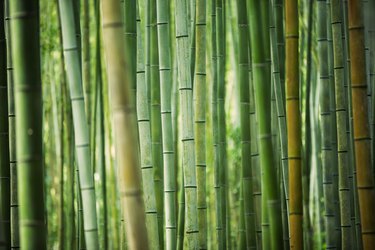
Although bamboo may be considered beautiful by admirers, it can quickly become an out-of-control invasive pest and send you on the search for the best weed killer for bamboo. Bamboo species are technically perennial, woody members of the grass family (Poaceae). Escaped bamboo can overcome stream banks, wooded areas and landscapes and threaten the biodiversity in an area. Bamboo is difficult to control or eliminate, but a multiyear effort with herbicides or a combination of chemical and mechanical removal methods may prove effective.
Nonselective Glyphosate Herbicide
Video of the Day
A nonselective glyphosate-based herbicide is typically the best herbicide choice for a homeowner or landscaper. Glyphosate will kill all plants it comes into contact with directly. Apply it with care on a non-windy day to ensure it doesn't kill other landscape plants or grass that you want to keep.
Video of the Day
Before application, the bamboo should be chopped or mowed and permitted to regrow until new leaves appear. Apply the glyphosate to the bamboo leaves according to the instructions on the herbicide label. Choose a calm day as wind can carry the herbicide to other areas and kill plants there. Multiple applications over two to three years will likely be necessary to eradicate the bamboo.
Diclobenil Weed Killer for Bamboo
Another treatment regime option is applying diclobenil in combination with glyphosate. The bamboo should be treated in winter with applications of diclobenil. This will kill a large number of the rhizomes and prevent others from re-establishing. Glyphosate is then used for spot sprays throughout the summer to control any emerging sprouts.
Treating Bamboo Near Water
If the bamboo population to be controlled is adjacent to a creek, lake, wetland or other water body, care should be taken when applying herbicides. The chemicals can easily get into the body of water, affecting the aquatic life in the area. It can also travel through the water to other areas. Use a glyphosate product that is labeled for use near water. These products typically combine glyphosate with a non-ionic surfactant to improve control.
Soil Sterilant Option
If the bamboo is invading an area where no vegetation is desired, such as driveways, along fences or in parking areas, the bamboo can be cut to the ground and the soil may be treated with any soil sterilant. No plant growth will occur in the area for at least a year and sometimes much longer, so soil sterilants should be used with caution. It kills all types of plants in the area. It can kill trees, shrubs and other plants if their roots grow into the treated patch of soil while the sterilant is still in its active state.
Mechanical Bamboo Removal
The most effective bamboo removal is typically repeated mechanical treatment followed by, if necessary, herbicide use. Small infestations may be removed by hand. Remove as much of the root mass and rhizomes as possible.
A barrier can also be placed to limit the spread of bamboo. Because the spreading bamboo rhizomes are shallow, typically growing less than a foot deep, a plastic, metal, concrete or treated wood barrier installed 18 inches deep can be effective. Two to three years of regular mowing can also eventually deplete bamboo rhizomes.